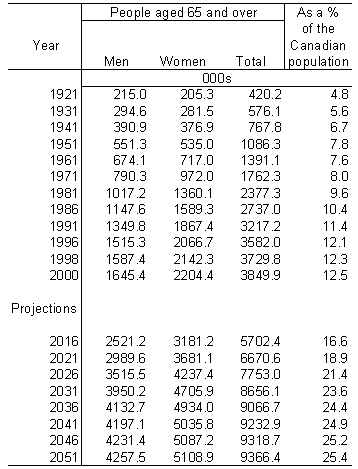 
|
|

No. 1 - A growing population
Seniors are one of the fastest growing population groups
in Canada. In 2000, there were an estimated 3.8 million Canadians aged
65 and over, up 62% from 2.4 million in 1981. In fact, the senior population
has grown about twice as fast as the overall population since the early
1980s.
As a result, more than one out of every 8 Canadians is now a senior.
In 2000, 13% of the population were seniors, up from 10% in 1981 and 8%
in 1971; it was also more than two and a half times the figure in 1921,
when only 5% of people living in Canada were seniors.
The rapid growth in the size of the senior population is also expected
to continue well into the future, particularly when those born during
the baby boom years from 1946 to 1966 begin turning age 65 early in the
second decade of the new century. Statistics Canada has projected, for
example, that by 2021 there will be almost 7 million seniors, who will
represent 19% of the total population, and that by 2041 there will be
over 9 million seniors, who will make up an estimated 25% of the population.
The senior population, however, is not a homogeneous group. At least
from a broad statistical perspective, people aged 65-74 more closely resemble
those in age groups under age 65 than they do those aged 85 and over,
while people aged 75-84 appear to be in a period of transition. Seniors
aged 85 and over, on the other hand, are the most likely to be characterized
by many of the conditions, such as ill health, associated with old age.
This is particularly significant because the population aged 85 and over
is the fastest growing segment of the overall senior population.
Population aged 65 and over
 Source: Statistics Canada
Source: Statistics Canada |
|



